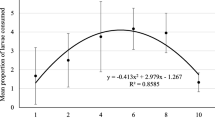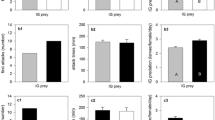Abstract
Orius insidiosus (Say) was observed to successfully prey on eggs and earlier instar larvae of the fall armyworm (FAW),Spodoptera frugiperda (J. E. Smith). Significantly more neonates of FAW were killed per 24 h than either 1, 2 or 3 d old larvae. Female and male predators exhibited a typical type-II functional response when preying on varying densities of eggs or neonates of FAW.
Résumé
On a observé que les adultes d'O. insidiosus mangeaient les œufs et les stades les plus jeunes de la chenille «légionnaire»Spodoptera frugiperda (J. E. Smith). Il y avait significativement plus de larves néonates tuées en 24 h que de larves âgées de 1, 2 ou 3 jours. Les prédateurs mâles et femelles ont montré une réponse fonctionnelle de type II lorsqu'ils se nourrissaient sur des densités variées d'œufs et de larves néonates de la chenille «légionnaire».
Similar content being viewed by others
References
Abbott, W. S. — 1925. A method of computing the effectiveness of an insecticide. —J. Econ. Entomol., 18, 265–267.
Barber, G. W. — 1936.Orius insidiosus (Say), an important natural enemy of the corn earworm. —U. S. Dept. Agri. Tech. Bull., 504, 24 p.
Dicke, F. F. &Jarvis, J. L. — 1962. The habits and abundance ofOrius insidiosus (Say) [Hemiptera-Heteroptera: Anthocoridae] on corn. —J. Kans. Entomol. Soc., 35, 339–344.
Duncan, D. B. — 1955. Multiple range and F tests. —Biometrics., 11, 1–42.
Garman, H. &Jewett, H. — 1914. The life history and habits of the corn-earworm [Chloridea obsoleta]. —Ky. Agric. Exp. Sta. Bull., 187, 511–91.
Gross, H. R. &Pair, S. D. — 1986. The fall armyworm: status and expectations of biological control with parasitoids and predators. —Fla. Entomol., 69, 502–515.
Gross, H. R., Pair, S. D. &Jackson, R. D. — 1985. Behavioral responses of primary predators to larval homogenates ofHeliothis zea andSpodoptera frugiperda [Lepidoptera: Noctuidae] in whorl-stage corn. —Environ. Entomol., 14, 360–364.
Holling, C. S. — 1959. The components of predation as revealed by a study of small mammal predation of the European pine saw fly. —Can. Entomol., 91, 293–320.
— 1965. The functional response of predators to prey density and its role in mimicry and population regulation. —Mem. Entomol. Soc. Can., 48, 1–86.
Isenhour, D. J. — 1980. Predator-prey relationships betweenOrius insidious (Say), and the soybean thrips,Sericothrips variabilis (Beach), on soybeans in Kentucky. —Ph. D. Thesis, University of Kentucky.
Isenhour, D. J. &Yeargan, K. V. — 1981a. Effect of crop phenology onOrius insidiosus populations on strip-cropped soybean and corn. —J. Ga. Entomol. Soc., 16, 310–22.
— 1981b. Effect of temperature on development ofOrius insidiosus, with notes on laboratory rearing. —Ann. Entomol. Soc. Am., 74, 114–118.
— 1981c. Predation byOrius insidiosus on the soybean thrips,Sericothrips variabilis: effect of prey stage and density. —Environ. Entomol., 10, 496–500.
Lewis, W. J. &Nordlung, D. A. — 1980. Employment of parasitoids and predators for fall armyworm control. —Fla. Entomol., 63, 433–438.
Luginbill, P. — 1928. The fall armyworm. —U.S. Dept. Agric. Tech. Bull., No. 34, 92 pp.
Pair, S. D. &Gross, H. R. Jr. — 1984. Field mortality of pupae of the fall armyworm,Spodoptera frugiperda (J. E. Smith), by predators and a newly discovered parasitoid,Diapetimorpha introita. —J. Ga. Entomol. Soc., 19, 22–26.
Perkins, W. D. — 1979. Laboratory rearing of the fall armyworm. —Fla. Entomol., 62, 87–91.
Provencher, L. P. &Coderre, D. 1987. Functional responses and switching ofTetragnatha laboriosa Hentz andClubiona pikei Gertsh for the aphidsRhopalosiphum maidis (Fich) andRhopalosiphum padi (L.) —Environ. Entomol., 16, 1305–1309.
SAS Insititute. — 1985. SAS user's guide: statistics version 5 edition. —SAS Institute Inc., Cary, NC. 956 pp.
Sparks, A. N. — 1979. A review of the biology of the fall armyworm. —Fla. Entomol., 62, 82–87.
Wiseman, B. R. — 1987. Host plant resistance in crop protection in the 21st century. —Int. Congr. Plant Prot. — Manila, Philippines. (In press).
Wiseman, B. R., Williams, W. P. &Davis, F. M. — 1981. Fall armyworm: resistance mechanisms in selected corns. —J. Econ. Entomol., 74 622–624.
Author information
Authors and Affiliations
Rights and permissions
About this article
Cite this article
Isenhour, D.J., Layton, R.C. & Wiseman, B.R. Potential of adultOrius insidiosus [Hemiptera: Anthocoridae] as a predator of the fall armyworm,Spodoptera frugiperda [Lepidoptera: Noctuidae] . Entomophaga 35, 269–275 (1990). https://doi.org/10.1007/BF02374802
Received:
Accepted:
Issue Date:
DOI: https://doi.org/10.1007/BF02374802




